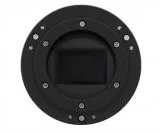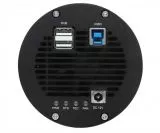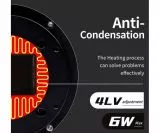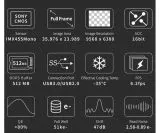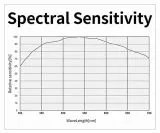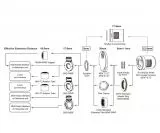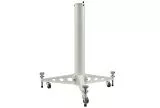- Details
- More images
Products description
TS-Optics ToupTek SkyEye62AM Gen-II full format monochrome astro camera, cooled - chip D=43.3 mm
Cooled USB 3.0 full-format astro camera with high sensitivity and zero-amp glow for deep-sky astrophotography - with new front plateFull-format black and white sensor Sony IMX455 - back-illuminated
Sensor size is 24 x 36 mm - diagonal 43.3 mm
61MP - 9568 x 6380 pixels
Pixel size 3.76 µm for high resolution
16 bit ADC - dynamic range like a CCD sensor
No amplifier glow thanks to zero-ampglow circuit
Coated entrance window also allows IR and UV to pass through
Heating built in to prevent condensation - sensor chamber is sealed airtight.
512 MB DDR3 buffer for stable data transfer
Binning is supported
M54x0.75 connection thread (internal thread)
Back focus 17.5 mm (distance sensor to M54x0.75 thread)
G2: The 5 mm thread adapter is removable for short adaptations, e.g. to a filter wheel. Then the back focus is only 12.5 mm
TS SkyEye 62AM full-frame black and white astro camera with Peltier cooling
This modern camera uses Sony's latest IMX455 full-frame 16-bit backlit ADC sensor. Thanks to 3.76 µm pixels, the camera can be used on almost all astronomical telescopes with good illumination.
Due to the high sensitivity of around 80% QE, we also recommend the camera for slightly weaker telescopes such as RC, EHD, ACF-Cassegrains or even refractors. Even at f/7 or f/8 you can take beautiful astro photos in just one night.
Back illumination technology:
Sony's back-illuminated CMOS image sensor improves sensitivity and noise reduction - key factors in improving image quality - by shifting the basic pixel structure from front to back exposure. The advantages of CMOS image sensors, such as low power consumption and high operating speed, have been retained.
Back exposure improves light capture while increasing the amount of light. This makes significantly shorter exposure times possible and leads to an improved quantum efficiency of 80%.
Sony has developed a unique photodiode structure and an on-chip lens optimized for back-illuminated structures, which results in higher sensitivity and lower random noise in the absence of light, reducing noise, dark current and defective pixels compared to the traditional front-illuminated structure.
No amplifier glow:
Conventional CMOS sensors produce a weak source of infrared light during operation, which can often be seen in the corners of uncalibrated images as a tell-tale sign of "amplifier glow." Because this camera's sensor uses a zero-ampglow circuit, you don't have to worry about "amp glow" even when using high-gain, long-exposure images.
Optimal support before and after purchase through Telescope Service:
Thanks to many years of experience, we can offer you optimal advice and also very good service after the purchase. We can carry out almost all services in-house. To ensure professional service, we also have a clean chamber where we can carry out repairs, cleaning, etc. without dust.
The camera manufacturer is ToupTek:
As one of the largest manufacturers of professional cameras for digital photography, ToupTek brings the necessary knowledge for cameras that simply work.
Detailed instructions:
Detailed instructions can be found from the manufacturer; you can download the PDF in English here.
Drivers and Software:
ToupTek provides drivers and software for this camera, you can download them here.
Good storage is an important prevention against dew and also extends the lifespan:
After use, put the camera straight into the TS Protect Case and add some silica gel. During storage, the silica gel sucks moisture out of the camera. At the same time, the penetration of moist room air is prevented. Dry storage means that even the small dry tablets can partially regenerate in cooled cameras. Your camera or accessories are always ready for you in optimal condition. You can find the silica gel and the case in our product recommendations.
The cameras are not airtight, so if the camera is left on the telescope, it will be exposed to moisture. The small amount of desiccant in the camera can protect the sensor and the inside of the protective glass from moisture for the duration of the recording, but not for days on the telescope. Moisture problems can result. A simple trick is to put a plastic bag around the focuser to which the camera is mounted so that no air can get in. Silica gel is placed in a small cloth bag in the plastic bag. This also creates a “dry climate zone” for the camera on the telescope. This means you can leave the camera on the telescope for a few days for a recording session lasting several days.
In the medium and long term, however, this cannot replace proper storage in an airtight case with silica gel.
Sensor Type: Sony IMX455 Monochrome
Sensor size: 36mm x 24mm, diagonal 43.3mm
Pixel size: 3.76 µm
Resolution: 9568x6380 (62 MPixels)
Shutter: Rolling Shutter
Exposure time: 0.1 ms to 3600 s
Readout speed at full resolution: 6.2 fps
ADC: 16 bits
Cooling: Powerful Peltier cooling up to 35 °C below ambient
Full Well: 51 ke-
Readout noise: 2.58 e- to 0.89 e-
Read buffer: 512 MB DDR3 memory
Sensitivity: Peak 80% QE at least
Zero Amglow Circuit: Yes
Entry window: AR coated glass
Anti-dew heater: Yes, maximum 6W
Power requirement: 12V, 3A
Power connection: 5.5/2.1mm barrel jack
Telescopic connection: M54x0.75 internal thread
Distance from M54 internal thread to sensor: 17.5 mm
Distance from front panel to sensor: 12.5 mm
Diameter: 89mm - Height 103mm
Weight: 0.718kg
camera
Dust cap
Power supply
USB 3.0 high speed cable - length 1.5 meters
Adapter ring M54 outside - M48 inside, 21 mm length
Extension sleeve M48, 16.5 mm length
Adapter ring M48 outside - T2 inside, 0 mm length
Allen key
This Product was added to our catalogue on 04/12/2024.
Categories
Quick purchase
Welcome back!
Last viewed:
Manufacturer
Shipping country

